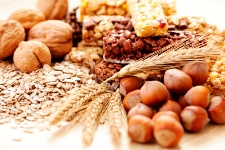 Of all the things you can do to boost your health, eating more fiber is surely one of the easiest and most beneficial. By eating just 30 grams of fiber a day (20 grams for women), you could protect yourself against a few dangerous health conditions.
Of all the things you can do to boost your health, eating more fiber is surely one of the easiest and most beneficial. By eating just 30 grams of fiber a day (20 grams for women), you could protect yourself against a few dangerous health conditions.
Fiber plays a very specific and special role in your body. Whereas fats, carbs, and proteins are broken down into smaller components and then sent throughout your body to help with the daily job of keeping you alive and well, fiber is left undigested. Why does your body ignore fiber in this way? Because it’s needed in your colon to help get rid of everything your body can’t use. All this left over stuff has to be cleared out before it can start to harm you.
There are two types of fiber: soluble and insoluble. Insoluble fiber plays the traditional role that most people associate with fiber—it helps to push digested food through your colon and increases the bulk of your stool. Why is this important? Insoluble fiber keeps you from being constipated.
MORE: 5 ways to soothe IBS symptoms
Constipation can be a problem if you haven’t had a bowel movement in over three days. Believe it or not, this fairly common health complaint can cause a barrage of symptoms. Irritability, weight gain, and hemorrhoids are all symptoms associated with your digestive system being backed up. Another problem that can occur that you might not be aware of is a build-up of fecal matter which can trigger body odor problems.
This is because the bad type of bacteria (as opposed to the good kind you have in your gut) can multiply and thrive in fecal matter that becomes stationary for too long in the colon. Also, some research points toward a link between constipation and headaches. If you’ve been suffering from painful bouts of pressure in your head, take note if you’re also suffering from constipation, as the two often go hand-in-hand and treating one could help get rid of the other.
Now, as for soluble fiber, it has a very different role to play. Insoluble fiber won’t dissolve in water but soluble fiber does. Its effects are more complicated in the body but suffice it to say that it helps to lower cholesterol and glucose levels, playing a role in both heart disease and diabetes prevention. Researchers think that soluble fiber works its magic by lowering LDL cholesterol levels, keeping high blood pressure in check, and staving off inflammation. As for diabetes, soluble fiber seems to help slow the absorption of sugar into the bloodstream and thus improves blood sugar levels.
One last bit of motivation to get you on a fiber diet? It could help in your efforts to lose weight. It isn’t that fiber itself makes you shed pounds—it’s more the process of dealing with fiber that gets your calorie count down. Fiber foods are generally low in calories (think fruits, veggies, whole grains cooked in their natural form, beans, and legumes). A high-fiber diet can also help you feel full and keep that feeling for longer periods of time, helping to stave off excessive snacking and overeating.
Source(s) for Today’s Article:
“Constipation,” The Mayo Clinic web site; http://www.mayoclinic.com/health/constipation/DS00063, last accessed May 26, 2013.
Gato, N., et al., “Persimmon fruit tannin-rich fiber reduces cholesterol levels in humans,” Ann Nutr Metab 2013; 62(1):1-6.
Jenkins, D.J., et al., “Soluble fiber intake at a dose approved by the US Food and Drug Administration for a claim of health benefits: serum lipid risk factors for cardiovascular disease assessed in a randomized controlled crossover trial,” Am J Clin Nutr. May 2002; 75(5):834-9.
Lappi, J., et al., “Do large intestinal events explain the protective effects of whole grain foods against type 2 diabetes?” Crit Rev Food Sci Nutr 2013; 53(6):631-40.
